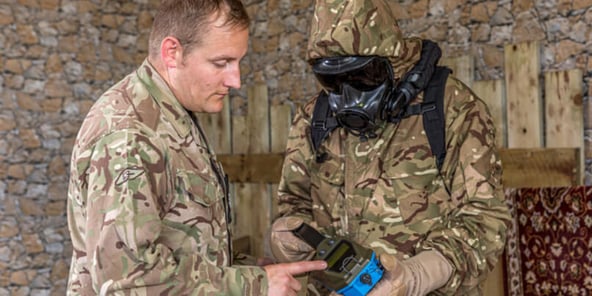
Regular and rigorous training has a hugely important role to play in ensuring that military personnel acquire the essential knowledge, experience and practical skills that their demanding roles require.
The invisible and intangible nature of many chemical, biological, radiological and nuclear (CBRN) threats however can make them especially challenging to train for, and especially so when it comes to the conducting of effective chemical agent detection.
Successful CBRN response relies on operatives having a thorough understanding of the properties of toxic chemical agents and being able to accurately recognize those substances in the course of their work.
Fulfilling the training requirements for chemical warfare agents (CWAs) for example, can be especially challenging.
Instructors want to ensure that their trainees are fully immersed and engaged in the experience, that they are confident in the use of their detector equipment and that they have the knowledge they need to make the right decisions and recommendations.
If the decision is made to use controlled quantities of chemical simulants then their use must be tightly regulated and stringently managed.
But given that only a handful of sites worldwide have the necessary permissions to handle even the smallest quantities of CWAs in an open environment, how can instructors safely test their trainees' understanding of the properties, response and detection of these hazardous substances?
Rethinking the approach to chemical warfare agent training
One traditional training method has been to use actual detector equipment in conjunction with simulant sources that are tailored to look like real agents and that replicate much the same response in the majority of detection technologies.
But when using even very small amounts of simulants the training environment can quickly become saturated and there is in an increased risk of students obtaining false positives.
Training with real detectors also requires that vital operational equipment is taken out of service.
While in some cases this might be just for the duration of the exercise, in other cases it may mean that equipment is unavailable for for an extended period of time while it is calibrated, repaired or possibly even replaced.
The success of any training exercise - and how effectively that knowledge can be retained and put into practice - will depend on the degree of realism that is created.
The use of electronic simulants in conjunction with simulator detectors offers a variety of advantages for both trainer and trainee.
There is greater ease of control, less risk of misuse and zero environmental impact.
Scenarios can also be conducted in a wide range of locations including vehicles and public spaces.
For trainees too there is the benefit of being able receive real feedback and to experience the challenging physical, environmental and and psychological conditions of the live field.
Testing CWA proficiency through hands-on training
The challenge of instilling realism in CBRN training was a key issue for Company Commander Chief Warrant Officer 5 Christopher Joy (Ret.) of the Fort Leonard Wood CBRN Instruction Company Marine Corps Detachment.
In the case study 'USMC 21st Century Military Training' CWO5 Joy emphasizes the need to provide "better training scenarios that truly test trainees' abilities."
Says CWO5 Joy: "In the past, instructors would simply have handed trainees a three by five card which said "Here is what the JCAD is telling you - and by the way this is happening.
"We were literally feeding our students everything."
The turning point came however when the decision was made to incorporate the use of simulator detector equipment into the Corps' existing programme of instruction.
Joy says he saw "vast potential" both in how simulators could be used and in the value that they could provide.
The overriding question though was - would they be able to replicate real-world Marine combat systems to a degree that a student wouldn't know that they weren't using the real thing?
The answer has been a resounding yes.
Since introducing the systems, trainee proficiency at the Fort Leonard Wood CBRN Instruction Company has gone up exponentially.
"The trainees like how the system provides them real feedback, and how it allows them to see and hear how the real gear will act in a real environment.
"It allows students to use technology that they're familiar with which increases their learning, knowledge and retention. I can only see simulators continuing to play a much more significant role."
To learn more about Fort Leonard Wood's experience of using electronic simulators in their program of instruction please click the link below to download a free case study.






